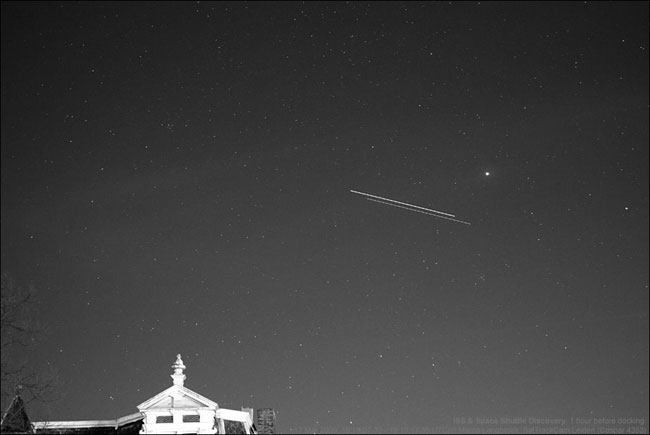Spot the Space Station in Night Sky This Fourth of July

Fireworks aren't the only lights in the night sky across the United States this Fourth of July. The International Space Station is up there too, just in time for the holiday weekend.
The space station is making a series of evening passes over parts of the United States through Monday, July 4, according the skywatching website Spaceweather.com.
The International Space Station is the largest and the brightest human-built object in orbit around the Earth. On good passes, the station's brilliance can rival the planet Venus and is more than 25 times brighter than Sirius, the brightest star in the sky. [Photos of Space Station and Shuttle From Earth]
The $100 billion space station is about as long as a football field and can clearly be seen with the unaided eye by observers who know where to look and have a clear night sky.
Skywatchers in Utah have already been treated to amazing space station views when the orbiting laboratory soared 220 miles (354 kilometers) above the Bryce Canyon Astronomy Festival, where more than 750 amateur astronomers had gathered, Spaceweather.com reported.
To find out where to look when the space station flies over your part of the country, you can visit these three websites:
Each site will require for your zip code or city in order to pull up sightings information, and then respond with a list of suggested spotting times.
Breaking space news, the latest updates on rocket launches, skywatching events and more!
Predictions are typically computed a few days ahead of time are usually accurate within a few minutes. However, viewing times can change due to the slow decay of the space station's orbit and the outpost's periodic reboosts to higher altitudes, so it is best to check your chosen website for updates.
Another great site is this one, which provides real-time satellite tracking and shows you at any given moment during the day or night over what part of the Earth the space station or shuttle happen to be.
The International Space Station is currently home to a six-man crew that includes two Americans, three Russians and one Japanese astronaut. The astronauts have the Fourth of the July weekend off in honor of the American holiday.
The station crew is also preparing for a busy month in space. On Friday, July 8, NASA plans to launch the final space shuttle flight on a mission to deliver supplies and spare parts to the space station.
The four-person crew for that final shuttle mission will arrive at NASA's Kennedy Space Center launch site in Florida on July 4.
Atlantis will fly a 12-day mission to the space station during the final shuttle flight. NASA is retiring its shuttle fleet to make way for a new program aimed at deep space exploration.
You can follow SPACE.com Managing Editor Tariq Malik on Twitter @tariqjmalik. Follow SPACE.com for the latest in space science and exploration news on Twitter @Spacedotcom and on Facebook.

Tariq is the award-winning Editor-in-Chief of Space.com and joined the team in 2001. He covers human spaceflight, as well as skywatching and entertainment. He became Space.com's Editor-in-Chief in 2019. Before joining Space.com, Tariq was a staff reporter for The Los Angeles Times covering education and city beats in La Habra, Fullerton and Huntington Beach. He's a recipient of the 2022 Harry Kolcum Award for excellence in space reporting and the 2025 Space Pioneer Award from the National Space Society. He is an Eagle Scout and Space Camp alum with journalism degrees from the USC and NYU. You can find Tariq at Space.com and as the co-host to the This Week In Space podcast on the TWiT network. To see his latest project, you can follow Tariq on Twitter @tariqjmalik.
